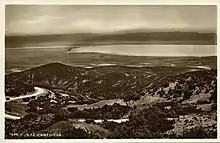Lake Amik or the Lake of Antioch (Arabic: بحيرة العمق; Turkish: Amik Gölü) was a large freshwater lake in the basin of the Orontes River in Hatay Province, Turkey. It was located north-east of the ancient city of Antioch (modern Antakya). The lake was drained between the 1940s–1970s.
Hydrology and history

Lake Amik was located in the centre of Amik Plain (Turkish: Amik Ovası) on the northernmost part of the Dead Sea Transform and historically covered an area of some 300–350 km2 (120–140 sq mi), increasing during flood periods.[1]: 2 It was surrounded by extensive marshland.
Sedimentary analysis has suggested that Lake Amik was formed, in its final state, in the past 3,000 years by episodic floods and silting up of the outlet to the Orontes River.[2] This dramatic increase in the lake's area had displaced many settlements during the classical period;[3] the lake became an important source of fish and shellfish for the surrounding area and the city of Antioch.[4] The 14th century Arab geographer Abu al-Fida described the lake as having sweet water and being 20 mi (32 km) long and 7 mi (11 km) wide,[5] while an 18th-century traveller, Richard Pococke, noted that it was then locally called "Bahr-Agoule (the White Lake) by reaſon of the colour of its waters".[6]
By the 20th century, the lake supported around 50,000 inhabitants in 70 villages, who took part in stock raising, reed harvesting, fishing (with a particularly significant eel fishery) and agriculture, crops and fodder being grown on pastures formed during the summer as the lake waters receded.[1]: 3 They also constructed dwellings, locally known as Huğ, from reeds gathered in the lake.
Ecology
Lake Amik was an extremely valuable habitat on the migratory routes of waterfowl and other birds, especially white storks and pelicans, and was noted for an isolated breeding population of the African darter. It also supported populations of endemic birds; a possible distinct subspecies of the black francolin (Francolinus francolinus billypayni) and the similarly distinct southern Turkish bearded reedling (Panurus biarmicus kosswigi). A ray-finned fish species Hemigrammocapoeta caudomaculata was only known from Lake Amik, while the cyprinid Jordan himri was found nowhere else in Turkey.
With the draining of the lake, the endemic bird and fish species have become extinct; the region's biodiversity was further harmed by the fact that one of the few similar habitats, Lake Hula in northern Israel, was also drained in the 1950s.
Draining
Draining and reclamation of areas around the lake commenced in 1940, in order to free land for growing cotton and to eliminate malaria. A major drainage project, channeling the lake's tributary rivers (the Karasu, the ancient Labotas, and the Afrin, the ancient Arceuthus or Arxeuthas) directly to the Orontes was undertaken from 1966 by the State Hydraulic Works, with further works completed by the early 1970s; by this time the lake had been completely drained, and its bed reclaimed for farmland.
As of 2007, Hatay Airport has been constructed in the centre of the lakebed.
There have increasingly been reports that the draining of Lake Amik has caused severe environmental damage. Reclaimed and irrigated land has been affected by increasing soil salinity, and productivity has fallen. Despite the drainage works, many areas still regularly flood, requiring constant maintenance of drainage canals and further decreasing the productivity of the reclaimed farmland, while the water table has fallen dramatically from an average of 20 m (66 ft) to 400 m (1,300 ft) at some points.[1]: 5–7 The fall in underground water levels has been implicated in causing an increasing amount of subsidence and serious damage to buildings.[7]
References
- 1 2 3 Çalişkan, V. Human-Induced Wetland Degradation: A case study of Lake Amik (PDF). Balwois. Archived from the original (PDF) on 13 February 2012.
- ↑ Alatas, A; Alp, EE; Friedman, ES; Jennings, G; et al. (1998). An X-Ray Fluorescence Study of Lake Sediments From Ancient Turkey (PDF). 47th Annual Denver X-ray Conference. Colorado Springs. p. 6.
- ↑ Yener, K; Wilkinson, T (1999). "The Amuq Valley Projects, 1998-99 Report". University of Chicago.
- ↑ This was noted by the 4th century rhetorician Libanius, a resident of the city, in his 11th Oration: "We have a greater supply of fish than many who live on the coast [...] Fortune has provided each man with his due: to the rich she has given the harvest of the sea, to the rest that of the lake" (transl. in Norman, A. Antioch as a Centre of Hellenic Culture as Observed by Libanius, Liverpool University Press, 2000, pp.60-61)
- ↑ Yener, K; Wilkinson, T (1996). "The Amuq Valley Projects, 1995-96 Report". University of Chicago. Archived from the original on 3 November 2013. Retrieved 19 June 2008.
- ↑ Pococke, R. in Pinkerton, J. A General Collection of the Best and Most Interesting Voyages and Travels in all Parts of the World, 1811, p. 545. This name would seem to be Arabic, but the Ottoman Turkish name Ak-Deniz (White Sea / Lake) is also recorded. Amik Gölü is used in modern Turkish.
- ↑ "Excessive use of underground water causes collapse". Today's Zaman. 17 July 2007. Archived from the original on 7 January 2008.